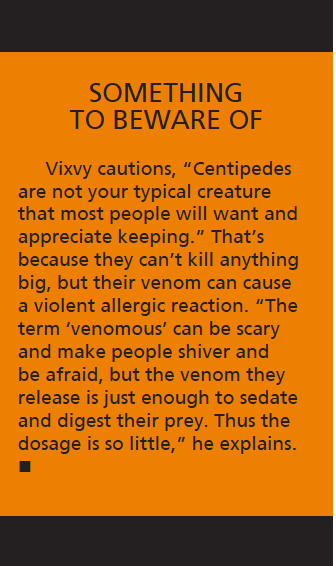“Beautiful” isn’t a word people associate with invertebrates, let alone centipedes. But the Indian giant tiger centipede or Scolopendra hardwickei is considered one of the most beautiful centipedes in the world―and one look will tell you why.
Hobbyist and Keepers of Extreme Exotic Philippines member Vixvy Panugayan explains, “There are many giant centipede species in the world, mostly of genus Scolopendra. A few stand out, like the Indian giant tiger centipede, because of its unique color pattern.”
With a sleek, shiny body whose segments alternate between red orange and black, it is a striking creature whose popularity is increasing among exotic fanciers. “Scolopendra species are very appealing in general due to their vibrant color and huge size,” Vixvy says. They can grow anywhere from at least 8 inches up to 14 inches in length, and he thinks this variation makes these centipedes appealing to people who like ‘weird’ things in nature.
Not for Amateurs
Much of what current keepers of Indian giant tiger centipedes know is from hard-won experience. A search online reveals no specific care sheets for the breed, only for its closest
relatives. “The sad thing in keeping these centipedes is that they are one of those
animals that many do not understand, and there are so few research studies about them. That is why I, as a keeper of centipedes, base everything I do on the experiences I share with my coenthusiasts,” Vixvy explains.
This explains why beginners with centipedes shouldn’t start with the Indian giant tiger centipede. There isn’t enough knowledge about the species and their care for an amateurmto make a good go of it. Besides, he advises, only a dedicated hobbyist with time to care for pets would make an ideal owner for these creatures.
As for the experience of those who have kept the animal, “They are escape artists!” he laughs when asks what a potential Indian giant tiger centipede keeper should watch out for.
A keeper’s priority, he adds, is to make sure that the enclosure they will provide the creature is escape-proof yet well ventilated. Their substrate should be partly moist, as this is the best habitat for them. Provide them with places to hide and a water dish. He cannot stress the importance of the enclosure enough. “I consider centipedes to be the ‘snakes’ of the invertebrate world. So treat them like snakes; use long forceps and escape-proof enclosures. NEVER handle them with bare hands or without the use of the proper tools,” he warns.
Another thing to avoid, he says, is the “show-off attitude” since their bite can pack a punch. Always respect the creature when handling it properly. “It fascinates me that they are voracious eaters and grow fast; body ratio-wise, they can take down prey twice their size. In order to avoid any mistakes in owning a centipede, new owners should always respect them and know what they can do.” In other words, educate yourself before you own one.
Keeping It Healthy
For one, Vixvy asks, did you know that the Indian giant tiger centipede is also like a snake in that it is very vital to the balance of nature? They contribute to controlling pests, as their diet primarily consists primarily of mice, locusts, cockroaches, and other vermin. They eat till they’re full, then proceed to molt.
 As insectivores and carnivores, they should not be given too much calcium, so he advises a diet with different kinds of feeders. Indian giant tiger centipedes are nocturnal creatures, “…so if you see them lively at night, then they are pretty much happy and adapted to their environment,” Vixvy says.
As insectivores and carnivores, they should not be given too much calcium, so he advises a diet with different kinds of feeders. Indian giant tiger centipedes are nocturnal creatures, “…so if you see them lively at night, then they are pretty much happy and adapted to their environment,” Vixvy says.
On the other hand, you should watch out for when their legs are curled somewhat towards their bodies; this means they’re not as happy or healthy as they can be. They may look quite colorful, but they are delicate creatures.
For one, you need to provide them with water; three days without it will kill them. You also can’t keep them together as communal creatures, he says. “They are very territorial, especially when mating occurs.” After mating, they should be separated.
Molting is a crucial part of their cycle; at this point, they are vulnerable because their exoskeleton is very soft, so make sure there are no feeders inside the enclosure to disturb them. Watch out for the so-called wet-molt; after a centipede molts, its exoskeleton is wrinkled when it should be shiny and smooth. “Sadly, it will die if wet molt occurs,” Vixvy says.
Photos by Jeffrey C. Lim
This first appeared as “A Gorgeous Centepede” in Animal Scene’s May 2015 issue.






